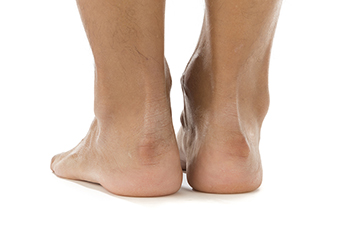
When a bumpy protrusion forms on the back of the heel, it is a sign that you may have a condition known as Haglund’s deformity. This condition is also less formally known as pump bump. Heredity is a known factor in causing Haglund’s deformity. People with high arches, those who walk on the outside of their foot, and those with tight Achilles tendons may be at higher risk of developing a pump bump. Another contributing factor is wearing dress shoes with rigid backs, which can lead to increased pressure on the enlarged bone and add to the pain. Symptoms of Haglund’s deformity include a bump on the heel bone, as well as redness, swelling, and pain where the heel and the Achilles tendon meet. If the pain of Haglund’s deformity becomes severe, it may be time to consult a podiatrist for a complete examination of the heel bone. This may include a variety of imaging tests and a gait assessment. Heel inserts, arch supports, or custom orthotics may be prescribed. In more severe cases, a walking boot, soft cast, or surgery may be an option. For more information, please consult a podiatrist.
Many people suffer from bouts of heel pain. For more information, contact Anas Khoury, DPM of North Eastern Foot & Ankle Specialists. Our doctor can provide the care you need to keep you pain-free and on your feet.
Causes of Heel Pain
Heel pain is often associated with plantar fasciitis. The plantar fascia is a band of tissues that extends along the bottom of the foot. A rip or tear in this ligament can cause inflammation of the tissue.
Achilles tendonitis is another cause of heel pain. Inflammation of the Achilles tendon will cause pain from fractures and muscle tearing. Lack of flexibility is also another symptom.
Heel spurs are another cause of pain. When the tissues of the plantar fascia undergo a great deal of stress, it can lead to ligament separation from the heel bone, causing heel spurs.
Why Might Heel Pain Occur?
- Wearing ill-fitting shoes
- Wearing non-supportive shoes
- Weight change
- Excessive running
Treatments
Heel pain should be treated as soon as possible for immediate results. Keeping your feet in a stress-free environment will help. If you suffer from Achilles tendonitis or plantar fasciitis, applying ice will reduce the swelling. Stretching before an exercise like running will help the muscles. Using all these tips will help make heel pain a condition of the past.
If you have any questions please contact our office located in Passaic, NJ . We offer the newest diagnostic and treatment technologies for all your foot and ankle needs.
